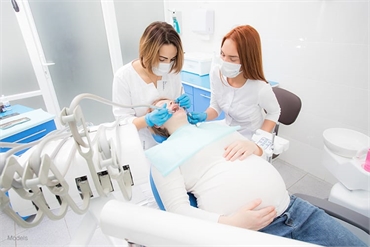Can I have a dental filling done if I’m currently pregnant?
November 01, 2022

During pregnancy, there is a range of hormonal changes that take place. There is a ten fold increase in oestrogen and thirty fold increase in progesterone hormones during pregnancy. The alteration in these hormones has an effect on the secretion of many bodily fluids. One of these is the saliva, which markedly decreases.
Saliva acts a as a defense mechanism by eliminating harmful pathogens that can cause caries. It also helps in keeping the oral cavity's pH under control and promotes the maintenance of gingival health. Pregnancy gingivitis, increased risk of caries and pyogenic granulomas are the most commonly seen oral conditions during pregnancy.
If cavitations do occur, then there is always a question of whether or not dental treatments should be prioritised. When it comes to cavitations, it is always wise to stop them earliest before they progress deeper into the tooth structure and lead to pain that would require a root canal treatment.
Dental filling treatments involve removing a carious lesion and later filling them with a biocompatible dental cement or restorative material. If a pregnant patient is to undergo a dental filling procedure, then a lot of factors need to be considered.
Timing for dental treatment of pregnant women
During the first trimester, only basic dental examination and prophylaxis is recommended. Dental filling procedures are recommended only in second and third trimester, i.e., after 12 weeks. Since morning sickness, nausea and vomiting are common during this stage, dental appointments must be adjusted accordingly. Patients are asked to empty their bladder before the treatment. They are also asked to have a healthy snack prior to the procedure.
Patient positioning when a pregnant female is in the dental chair
During the second and third trimester, since the weight of the foetus increases, it is not wise to ask the patient to lie down in a supine position on the dental chair. This is because lying the patient down would lead to the weight of foetus get transferred to the major blood vessels of the heart. This can lead to hypotension. In the third trimester, the patient is placed in a semi-reclined position in order to avoid heartburn. If at all for access to the concerned tooth, a supine position is needed, then the patient should be in that position for no more than 7 minutes.
Apart from the chair positioning, patient is also made to lie down in a left lateral position. In order to do so, a pillow is placed under the patient's right side to roll them towards the left. During this trimester, at a minimal dosage, taking radiographs is also considered safe for the foetus.
Dental filling material for pregnant patients
The type of dental filling material used is very important. Previously, amalgam was the restorative material of choice. However, in pregnant patients, if an amalgam is placed, then it can release mercury vapors that travel in the bloodstream and can also cross the placenta. There is very less documentation as to the toxic effects of mercury on the foetus. It can thus be only be done if a dentist exercises strict isolation under rubber dam that vastly decreases the absorption of mercury.
Composite and Glass Ionomer Cements are two restorative materials that are tooth colored, have bioactivity and require less removal of healthy tooth structure. They have been preferred over amalgam over quite some time now. Despite the presence of monomers like bisphenol-A in composite, it is still not conclusive if it has any long term negative effect on the foetus. There is a lack of data on which filling material shows the least adverse effects in pregnant patients.
Dental fillings are considered safe procedures during pregnancy. The reason why these procedures are not considered safe in the first trimester is because during this time organogenesis takes place. This means that since vital organs take shape, it would not be wise to take a risk of exposing the foetus to chemicals that may prove harmful during development. Secondly, many patients undergo abortions during this time because of which dental treatments are not risked.
A basic understanding of dental treatments during pregnancy is mandatory to know for both the mother and the dentist. Preventive measures like consumption of xylitol during pregnancy can help reduce the chances of developing caries. Procedures like dental fillings are relatively less invasive and can be carried out with ease by keeping in mind the above-mentioned clinical points.

